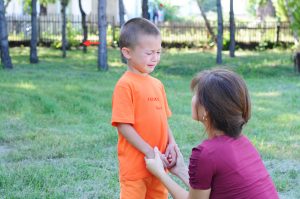Some children suffer from stress and anxiety from the time they are preschool age, while others develop it in grammar school or the teenage years. Parents often feel unprepared and frustrated when trying to help their child overcome these issues. Many times parents cannot differentiate between a serious anxiety disorder or the more common emotion of simply feeling fearful or stressed in a new or challenging situation. Sometimes it is simply the child’s temperament or personality that causes them to react more emotionally than other children. As parents, we are our children’s first teacher, and when prepared we can teach our anxious child how to manage their emotions. When we give our children the tools they need to face their fears, they feel empowered and more confident.
Parents often feel paralyzed by their own fears and anxiety or guilty because they feel responsible for their child’s difficulties. It is important to realize that anxiety is a common emotion that when managed and understood can help children learn more about themselves and their emotional health.
Of course, if your child is struggling daily with anxiety and it is impeding their ability to participate in school or other daily activities, professional counseling and support are advised.
But if you need advice on how to help your child manage anxiety that may arise occasionally, here are some helpful tips.
What Is Anxiety
It is important to name the feeling or emotion your chid is experiencing. Explain that everyone experiences anxiety or feelings of stress and worry. Don’t minimize how your child is feeling, empathy goes a long way in helping your child express their feelings freely, while reducing their worries. Ask your child to explain what they are feeling and why. Perhaps they are having physical symptoms as a result of their worries. Children often complain of an upset stomach or headache when they are stressed. Normalizing anxiety or explaining that anxiety is something everyone feels at one time or another can help in reducing a child’s stress level. Simply explain that everyone experiences anxiety from time to time, even adults. Listen and be empathetic to your child’s feelings. Tell them you understand they are afraid and that you are here for them, and will help them though this.
As parents we should also be aware of how we respond to anxiety ourselves. Our children are watching us. Are you calm in stressful situations? What tools do you use to alleviate your stress?
Walk Through the Worst Case Scenario
If you have a worried child, they often suffer from anticipatory anxiety, or fear of what will happen in the future. When this is the case, a helpful tactic in reducing stress for them is taking your child step by step through the anxious situation they are fearing. Talk about what will happen first and give simple and clear directions on what your child can do, if what they fear most actually does happen. While talking through each step, problem solve and role play. Come up with possible solutions to their perceived threats. Express confidence that it will be okay.
Self Soothing Techniques
Give your child the tools to manage anxiety. Teaching children simple meditation and breathing exercises has been found to greatly reduce stress in children. Deep breathing reverses the anxiety response from the central nervous system and allows the child’s intellect or logical part of the brain to take over. Meditation and deep breathing is a self soothing technique they can and will continue to use throughout their life. Mindfulness or staying in the present, can also help a child calm down. Encouraging your child to stay in the present moment, even using distraction as a way to take them away from their worries is a useful tool. Writing down fears and putting them in a jar is another strategy that has often been used to help children manage and alleviate worry. Providing your child with tools empowers them and allows them to walk through the fear instead of avoiding it.
Exercise
Take a walk or a bicycle ride with your child. Exercise has been shown to reduce stress and anxiety in both children and adults. Parents are encouraged to find a physical activity that your child enjoys and make that a part of their daily life. Incorporating daily exercise increases a child’s sense of well being by releasing endorphins and triggering a positive feeling in the body and a general sense of well being. Exercise has also shown to increase concentration and academic performance in children of school age years.
Recognizing Triggers
Helping your child to recognize that in certain situations they seem to feel more anxious or fearful than others is an important way to teach them about potential triggers or situations that have produced fear and anxiety in the past. The idea is not to avoid the situation, but gradually expose your chid to the anxiety producing trigger. Encourage your child to focus on the positive. If they are fearful of particular social situations, try to remind them of the fun activities they will be participating in. By coaching your child to face their fears, you are empowering them and providing reassurance that they will be okay.
Remember that that throughout their lives, our children will continually be exposed to stress and anxiety. By providing them with the skills and tools to face their fears, our children will be better prepared to manage their emotions. Leaving them with a stronger sense of self esteem and greater confidence in their ability to face life’s challenges.


Recent Comments